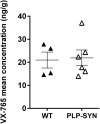Reducing C-terminal truncation mitigates synucleinopathy and neurodegeneration in a transgenic model of multiple system atrophy
- PMID: 27482103
- PMCID: PMC5003293
- DOI: 10.1073/pnas.1609291113
Reducing C-terminal truncation mitigates synucleinopathy and neurodegeneration in a transgenic model of multiple system atrophy
Abstract
Multiple system atrophy (MSA) is a sporadic orphan neurodegenerative disorder. No treatment is currently available to slow down the aggressive neurodegenerative process, and patients die within a few years after disease onset. The cytopathological hallmark of MSA is the accumulation of alpha-synuclein (α-syn) aggregates in affected oligodendrocytes. Several studies point to α-syn oligomerization and aggregation as a mediator of neurotoxicity in synucleinopathies including MSA. C-terminal truncation by the inflammatory protease caspase-1 has recently been implicated in the mechanisms that promote aggregation of α-syn in vitro and in neuronal cell models of α-syn toxicity. We present here an in vivo proof of concept of the ability of the caspase-1 inhibitor prodrug VX-765 to mitigate α-syn pathology and to mediate neuroprotection in proteolipid protein α-syn (PLP-SYN) mice, a transgenic mouse model of MSA. PLP-SYN and age-matched wild-type mice were treated for a period of 11 wk with VX-765 or placebo. VX-765 prevented motor deficits in PLP-SYN mice compared with placebo controls. More importantly, VX-765 was able to limit the progressive toxicity of α-syn aggregation by reducing its load in the striatum of PLP-SYN mice. Not only did VX-765 reduce truncated α-syn, but it also decreased its monomeric and oligomeric forms. Finally, VX-765 showed neuroprotective effects by preserving tyrosine hydroxylase-positive neurons in the substantia nigra of PLP-SYN mice. In conclusion, our results suggest that VX-765, a drug that was well tolerated in a 6 wk-long phase II trial in patients with epilepsy, is a promising candidate to achieve disease modification in synucleinopathies by limiting α-syn accumulation.
Keywords: alpha-synuclein; caspase-1; multiple system atrophy; truncation.
Conflict of interest statement
The authors declare no conflict of interest.
Figures







Similar articles
-
Overexpression of α-Synuclein by Oligodendrocytes in Transgenic Mice Does Not Recapitulate the Fibrillar Aggregation Seen in Multiple System Atrophy.Cells. 2020 Oct 29;9(11):2371. doi: 10.3390/cells9112371. Cells. 2020. PMID: 33138150 Free PMC article.
-
ATH434 Reduces α-Synuclein-Related Neurodegeneration in a Murine Model of Multiple System Atrophy.Mov Disord. 2021 Nov;36(11):2605-2614. doi: 10.1002/mds.28714. Epub 2021 Jul 8. Mov Disord. 2021. PMID: 34236731
-
Insulin resistance and exendin-4 treatment for multiple system atrophy.Brain. 2017 May 1;140(5):1420-1436. doi: 10.1093/brain/awx044. Brain. 2017. PMID: 28334990 Free PMC article.
-
Animal models of multiple system atrophy.Neuroscience. 2012 Jun 1;211:77-82. doi: 10.1016/j.neuroscience.2011.09.044. Epub 2011 Sep 25. Neuroscience. 2012. PMID: 21963351 Review.
-
Multiple system atrophy: experimental models and reality.Acta Neuropathol. 2018 Jan;135(1):33-47. doi: 10.1007/s00401-017-1772-0. Epub 2017 Oct 20. Acta Neuropathol. 2018. PMID: 29058121 Free PMC article. Review.
Cited by
-
Current Management and Emerging Therapies in Multiple System Atrophy.Neurotherapeutics. 2020 Oct;17(4):1582-1602. doi: 10.1007/s13311-020-00890-x. Neurotherapeutics. 2020. PMID: 32767032 Free PMC article. Review.
-
Age-dependent aggregation of α-synuclein in the nervous system of gut-brain axis is associated with caspase-1 activation.Metab Brain Dis. 2022 Jun;37(5):1669-1681. doi: 10.1007/s11011-022-00917-6. Epub 2022 Jan 28. Metab Brain Dis. 2022. PMID: 35089485
-
Cryo-EM structure of alpha-synuclein fibrils.Elife. 2018 Jul 3;7:e36402. doi: 10.7554/eLife.36402. Elife. 2018. PMID: 29969391 Free PMC article.
-
Multiple System Atrophy - State of the Art.Curr Neurol Neurosci Rep. 2017 May;17(5):41. doi: 10.1007/s11910-017-0751-0. Curr Neurol Neurosci Rep. 2017. PMID: 28378233 Review.
-
Transcriptional dysregulation in the cerebellum triggered by oligodendroglial α-synucleinopathy: insights from a transgenic mouse into the early disease mechanisms of MSA.J Neural Transm (Vienna). 2025 Feb 15. doi: 10.1007/s00702-025-02892-5. Online ahead of print. J Neural Transm (Vienna). 2025. PMID: 39954078
References
-
- Spillantini MG, et al. Filamentous alpha-synuclein inclusions link multiple system atrophy with Parkinson’s disease and dementia with Lewy bodies. Neurosci Lett. 1998;251(3):205–208. - PubMed
-
- Papp MI, Kahn JE, Lantos PL. Glial cytoplasmic inclusions in the CNS of patients with multiple system atrophy (striatonigral degeneration, olivopontocerebellar atrophy and Shy-Drager syndrome) J Neurol Sci. 1989;94(1-3):79–100. - PubMed
-
- Rochet JC, Conway KA, Lansbury PT., Jr Inhibition of fibrillization and accumulation of prefibrillar oligomers in mixtures of human and mouse alpha-synuclein. Biochemistry. 2000;39(35):10619–10626. - PubMed
Publication types
MeSH terms
Substances
Grants and funding
LinkOut - more resources
Full Text Sources
Other Literature Sources
Research Materials
Miscellaneous

